July 29, 2022
Air Date: July 29, 2022
FULL SHOW
SEGMENTS
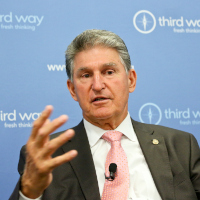
Sen. Manchin Supports Climate Bill
View the page for this story
In a surprise reversal, moderate Democratic Senator Joe Manchin of West Virginia has signaled support for a major climate package that would boost clean energy tax incentives and potentially help the U.S. reduce greenhouse gas emissions by around 40 percent by 2030. Host Jenni Doering shares a brief overview of what the bill includes for clean energy, environmental justice and more. (01:39)
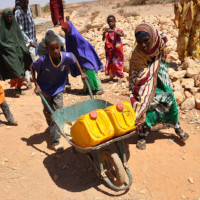
Extreme Drought Causes Famine in East Africa
View the page for this story
A punishing drought in the Horn of Africa means farmers and pastoralists can no longer grow food locally and some 19 million people in Ethiopia, Somalia, and Kenya don’t have enough to eat. Aliow Mohamed, the Somalia Country Director with the NGO Islamic Relief Worldwide, joins Host Bobby Bascomb to shed light on the situation and how to help. (12:04)

Migratory Monarch Butterflies Now Endangered
View the page for this story
One of the world's most beloved insects, the migratory monarch butterfly, has been declared endangered by the International Union for Conservation of Nature as upwards of 80% of migratory monarchs have died off in the past two decades. Tierra Curry, senior scientist with the Center for Biological Diversity, joins Host Bobby Bascomb to discuss what can be done to help save the iconic butterflies. (07:43)
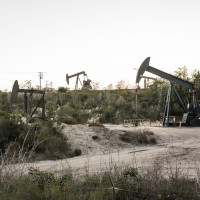
The Health Toll of L.A.’s Oil Rigs
View the page for this story
There are about 700 active oil and gas wells in the city of Los Angeles, mostly located in minority communities like the one where young activist Nalleli Cobo grew up, just 30 feet from a well. She and her neighbors have suffered for years from headaches, asthma, and cancer -- illnesses linked to the proximity of oil well sites. For her work fighting the oil companies operating those wells Nalleli was awarded the 2022 Goldman Environmental prize. She spoke with Living on Earth's Paloma Beltran. (11:04)
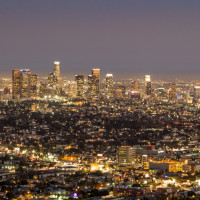
Beyond the Headlines
/ Peter DykstraView the page for this story
This week, Environmental Health News editor Peter Dykstra tells Host Jenni Doering about how urban light pollution might be extending allergy season. A Congressional subcommittee pressures EPA to take Seresto flea collars off the market over safety concerns. They then look back 32 years to Iraq’s invasion of oil-rich Kuwait. (04:03)
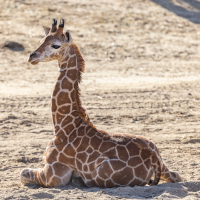
A Leg Up for a Baby Giraffe
View the page for this story
A baby giraffe at the San Diego Zoo Safari Park named Msituni was born with a disability that gave her trouble walking. So her veterinary team found a creative way to help her heal. Matt Kinney, senior veterinarian at the Safari Park, joins Host Jenni Doering to talk about Msituni and her special leg braces. (09:48)
Show Credits and Funders
Show Transcript
220729 Transcript
HOSTS: Bobby Bascomb & Jenni Doering
GUESTS: Nalleli Cobo, Tierra Curry, Matt Kinney, Aliow Mohamed
REPORTERS: Peter Dykstra
[THEME]
BASCOMB: From PRX – this is Living On Earth.
[THEME]
BASCOMB: I’m Bobby Bascomb.
DOERING: And I’m Jenni Doering.
More than 19 million people are malnourished and risk starvation in the Horn of Africa.
MOHAMED: With four consecutive rains having failed, then of course animals have died, no places for farming, people are now food insecure, where people are now dying because of starvation, where people and animals have died because of lack of water…
BASCOMB: Also, migratory monarch butterflies are internationally listed as endangered species.
CURRY: In the United States in summer, so many people have happy memories of watching them metamorphose or watching clouds of monarchs fly over in the migration, and it's kind of a test of: can we save them? If we can't save this super popular endangered species, then what are we willing to do to fight climate change and to fight extinction?
BASCOMB: That and more this week on Living on Earth – stick around!
[NEWSBREAK MUSIC: Boards Of Canada “Zoetrope” from “In A Beautiful Place Out In The Country” (Warp Records 2000)]
[THEME]
Sen. Manchin Supports Climate Bill
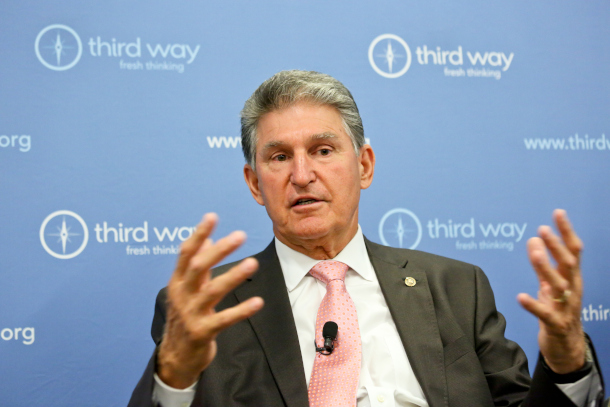
Senator Joe Manchin in 2017 (Photo: Third Way Think Tank, Flickr, CC BY-NC-ND 2.0)
BASCOMB: From PRX and the Jennifer and Ted Stanley Studios at the University of Massachusetts Boston, this is Living on Earth. I’m Bobby Bascomb.
DOERING: And I’m Jenni Doering.
In an evenly divided Congress, Moderate Democrat Joe Manchin has been a critical hold out vote for climate legislation…until now. The West Virginia Senator has announced he will support a $369 billion dollar climate bill put forward by his party. That’s just weeks after saying he could not support it, citing concerns about inflation. The bill is part of a larger reconciliation bill that can pass through the Senate without any Republican votes of support. Senate Democrats hope the bill will pass in a matter of days and claim that it would help the U.S. reduce greenhouse gas emissions by around 40 percent by 2030. It would do so by boosting tax incentives for wind, solar, geothermal, hydrogen, and other clean energy industries. There are also incentives for Americans hoping to buy a clean electric car amid historic gas prices. And the bill offers over $60 billion for environmental justice programs. It does include some concessions to the fossil fuel industry, such as a mandate for new oil lease sales in the Gulf of Mexico. Senator Manchin has received more money from the fossil fuel industry than any other member of the current Congress. It’s unclear why he had a sudden change of heart in supporting this bill, but on the West Virginia radio program Talkline, he referenced the war in Ukraine.
MANCHIN: Putin has weaponized energy. And we have to fight that with better energy, more energy, and much more cleaner producing energy. That bill invests into that, while we also invest in the new technologies of the future for the transition of future energies.
DOERING: We’ll have more details on Senator Manchin and the climate bill in the coming weeks.
Related links:
- Read a 4-page summary of the energy security and climate change investments in the Inflation Reduction Act of 2022
- NYTimes | "Surprise Deal Would Be Most Ambitious Climate Action Undertaken by U.S."
- Inside Climate News | "Senate Democrats Produce a Far-Reaching Climate Bill, But the Price of Compromise with Joe Manchin is Years More Drilling for Oil and Gas"
[MUSIC: Darol Anger and Mike Marshall, “Dolphins” on Chiaroscuro, Darol Anger, BMG Music]
Extreme Drought Causes Famine in East Africa
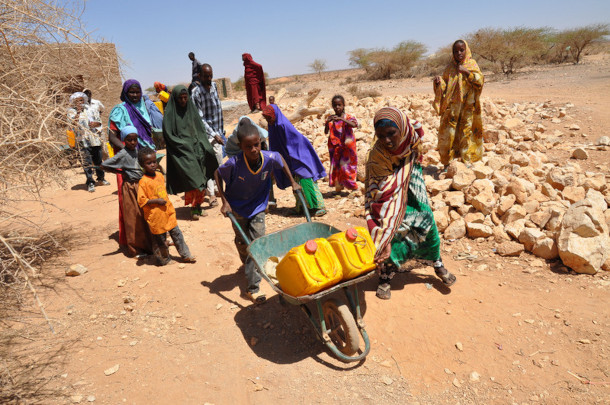
Faadomo Hirsi and her grandson wheel their daily water allowance of two 20-liter jerrycans back to their house in Somalia. (Photo: Alun McDonald, Flickr, Oxfam, CC BY-NC-ND 2.0)
BASCOMB: In the last decade, the Horn of Africa has experienced three severe droughts. The current drought has been going on for roughly two years. The countries of Ethiopia, Somalia, and Kenya haven’t had the seasonal rains that farmers and pastoralists depend on. The punishing drought has resulted in a severe food shortage; some 19 million people don’t have enough to eat. The region is in crisis amid starvation and malnutrition on a massive scale and millions of people are seeking help in IDP camps for internally displaced people. Scientists tell us that climate change is largely to blame and project the problem will only get worse in the future. Most of the region is expected to get hotter and drier in the coming decades. Aliow Mohamed is the Somalia Country Director with the NGO Islamic Relief Worldwide and joins me now for more. Aliow, welcome to Living on Earth!
MOHAMED: Thank you, Bobby, for having me. It's my pleasure.
BASCOMB: This is a region where irrigation really just isn't available at any scale. So, this lack of rain has been just devastating for agriculture. Can you tell us about that please?
MOHAMED: People here are dependent on livestock, their livelihoods are mainly on livestock, on farming. And with four consecutive rains having failed, then, of course, animals have died. No places for farming, I mean, there's no farming. So basically, the buildup of the failure of rainfall has resulted to catastrophic status where people are now food insecure, where people are now dying because of starvation, where people and animals have died because of lack of water. And people are now heading to the IDP camps where maybe NGOs like Islamic Relief and other organizations are providing support. So these are the people who have just abandoned forcefully, not by will, but forcefully, by the circumstances, their livelihood, and now ending up begging, and even losing some of their childrens and you know, the everything.
BASCOMB: I've read that close to 19 million people across the Horn of Africa are experiencing food insecurity and malnutrition. I think you know, for a lot of our listeners, that number is just hard to wrap your mind around, it's hard to imagine that much suffering. You've traveled across the region. Can you tell us please, what does that really mean? What does that really look like on the ground?
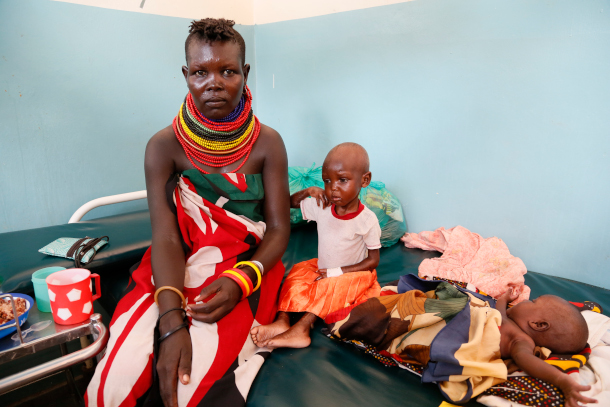
Two-year-old girl Erukudi, her mother Helen and baby sister, pictured in Lodwar Hospital, Turkana County, Northern Kenya. Erukudi is suffering from severe acute malnutrition and is being treated with a high-energy milk formula to help her regain weight. (Photo: Russell Watkins, Flickr, DFID, CC BY 2.0)
MOHAMED: I think 19 million is just the data we have up to date, the number will continue increasing. And most likely, by the end of the year, we might be hitting 30 million basically, you know, if not more. And of course, the region that is most suffering currently is Somalia and Ethiopia. And in Somalia, basically, the situation is really, really worse due to weak government, prolonged conflict. And all these things have contributed to the number just increasing. For example, in Somalia, we are talking of closer to 7 million people food insecure, almost 3.5 million people are in displaced camps. And close to 1.6 million children are malnourished. And closer to 6.5 million people have no access to water.
BASCOMB: Yeah, I just, how do people manage? How do people deal with that? I understand that millions of people have had to leave their homes against their will, as you point out, they're in displacement centers and refugee camps and that sort of thing. Can you describe that for us, describe the journey that people are taking to these places to seek some semblance of health and safety? What do those camps look like?
MOHAMED: Actually, two weeks ago, I was in one of the biggest camps in southwestern states in Somalia, in a place called Baidoa. This camp hosts closer to 500,000 people. And the time we visited, we met with a mother with her five kids. And out of five kids, three, she left with the father and she managed to come with two. And she told us she traveled almost for seven days with no food, no water. And she was lucky at least that she has reached that camp. And even that camp, she will not be able to get food or even water or even any support because as the number increases, the few NGOs who are providing the supports are overstretched. So the new people who are coming or the new groups who are coming from their homes, coming to look for source of livelihood, are not able to get an immediate support. So sometimes they can even stay within the camp for two or three days without maybe getting any support. And sometimes the good thing is the Somalis, you know they have this culture of sharing. So maybe if an NGO is giving a food commodity, maybe of 10 kg of rice, or 10 kg of wheat flour, then they split up and they share this. And this mother was telling us and she's heavily pregnant, she was actually nine months pregnant, and she has to travel all that. And she said some times along the road there are hyenas, there are you know a number of wild animals, whom she has to make sure that you know her children are covered. And the good thing is at least there was a group of them, but they have lost along the way some of their people whom they left together from their villages, going for those seven days to those camps. So the camp, coming to the status of the camp. There are no health facilities, no washing facilities, maybe latrines or even there is no basic shelter, no places for them to sleep. So they're just making up some makeshift, you know, with a tattered cloths on top, and their childrens are just sleeping under these. It's really very, you know, heartbreaking situations. When food is basically human rights, people are starving because of lack of food, people are starving because of lack of water. It's really, it's really touching and that is the kind of situation you know, that we have in the camps.
BASCOMB: Wow. That is a heartbreaking story that you share with us. What kind of resources are you seeing from the international community? It sounds like not nearly enough, obviously. But what's happening there that there's such this dramatic shortfall?
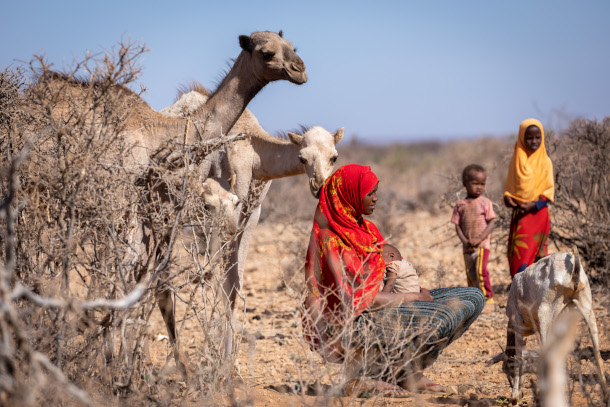
Zaynab Wali, a mother of seven children, used to sell some of her goats to supplement her income. But she lost almost half the goats to the current severe drought in Saglao village in Ethiopia. (Photo: Mulugeta Ayene, Flickr, UNICEF Ethiopia, CC-BY-NC-ND-2.0)
MOHAMED: You know, usually every year through the United Nation, international NGOs come together and there's what we call the Humanitarian Response Plan. And these response plan usually have a target, for example, the one for Somalia is $1.5 billion, that can be able at least to take care of this crisis. But up to now, only 16 to 20% have been committed. And you know, we almost the years almost ending, and the need is too much. So basically, the plan has been set, the response plan has been done with clear targets of what needs to be done in terms of food, in terms of health, in terms of water, to be provided to these people, but then the international communities are not coming on board as much as it is required to fulfill this obligation.
BASCOMB: Now, the drought in the Horn of Africa that we've been talking about is arguably the most acute case of agricultural collapse in the world right now. But we're also seeing extreme heat events in India that have affected the crops there, here in the US, you know, we have fire, droughts, floods that are impacting what we can grow, and of course, the war in Ukraine has led to a shortage of many grains. These shortages are inherently driving up the cost of food. What are you seeing there in terms of the cost of food? I mean, you can't grow your own, because there's just no rain, and importing it has to be that much more expensive.
MOHAMED: Yes, I think that is very, very true. In Somalia, basically, most of the food commodities are being imported. And I think most of the wheat because it's basically more of like a staple food for Somalis. And with the war in Ukraine, of course, the price has escalated. And of course, the impact of the COVID as well. I have an example where recently we contracted a supplier to provide food ration for six months. We booked like a supplier for six months to supply a ration to 600 households. Initially, when we budgeted it was one household per month was $60. And after one month, it jumped to $80. And this guy just delivered one, one ration and then second month, he come back to us and he said, you know, you have to increase it by $20 for me to be able to supply the food. And he said this is just for this month and next month, we don't know what will happen. And we have to now, you know, put on hold, discuss with the donor. And what happened is now we have to cut the ratio of the number of the people now we are targeting. You can imagine initially you targeted 600, now you reduced to 400, because the other 200 now cannot be able to be catered for. So these are the impact of the Ukraine conflict is actually biting and we are feeling it right in the field where we are providing this support to the people who are in the camps.
BASCOMB: What can anyone do who's listening to us? You know, I think the story is so heartbreaking that it's just, you know, people want to help, but what can the average person listening to us do to be helpful?
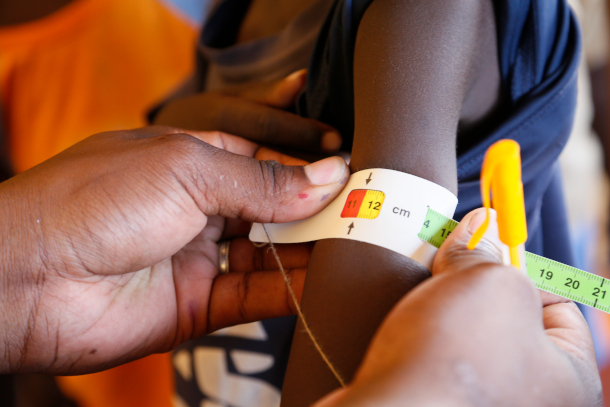
International Rescue Committee staff measure the upper arm circumference of 7-year-old Ngikadelio Ngikeny as part of a malnutrition screening program, at a health clinic in Turkana County, northwest Kenya, 29 March 2017. (Picture: Russell Watkins, Flickr, DFID, CC BY 2.0)
MOHAMED: For example, for us, Islamic Relief food is very critical at this point in time. We need health, we need medicine, because within the IDP camps children are, you know, suffering from respiratory, suffering from skin diseases, suffering from wasted bodies, and you know, suffering from all sorts of illness. Elderly people are dying due to lack of water, so therefore, we need water. So those are the three critical basic thing that we need, so that we can be able to stop or mitigate famine, or mitigate people from dying in mass, as it has happened in 2011. When the donors only come in, money only come after people have already perished. You know, we don't want to reach that level. We have seen in a camp for example, in one of the camp, we saw closer to 70 children died in one month, you can imagine, in one month. And that was just in June, not even July. I mean every other month, things just get more severe and worse as the time goes. So, even a small amount of money that is directed to save one household, I mean is very important at this point than any other thing.
BASCOMB: Aliow, you know, this situation in the Horn of Africa is just heartbreaking but you still show up every day and you're still working so hard for the people of the region. What gets you out of bed every morning? What still gives you hope?
MOHAMED: That's a very good question. Sometimes you go to the field and you just become emotional. You know, if you know that a mother with her children have not had food for the last four days, you know, a child of 3 years old, a child of you know 5 years old. But I think, you know, the hope we have is at least, I mean, we just go and tell them, you know, that we are here, you have not been abandoned, we are trying to reach out to the other parts of the world, so that we can be able to come and support you. Human being like me and you, I mean, we have to feel for one another. And you just can't see your fellow human being perish, you know, due to lack of food, due to lack of just basic commodities. I mean, it's more of like a call, so where you have to go and you know, support this community as much as you can.
BASCOMB: Aliow Mohamed is the Somalia Country Director at Islamic Relief Worldwide. Aliow, thank you so much for sharing these stories with us today and for all of your hard work.
MOHAMED: Thank you very much, Bobby for having me.
BASCOMB: If you’d like to help the people of East Africa, visit the Living on Earth website, loe.org, where we will link to organizations that are providing aid, including Islamic Relief World Wide, the World Food Program, and others.
Related links:
- World Meteorological Association | “Drought Tightens Grip in Eastern Africa”
- CBC | “Water Scarcity and Drought in East Africa Are 'Everybody's Problem,' Says UN Scientist”
- UN Environment Programme | “On Verge of Record Drought, East Africa Grapples with New Climate Normal”
- Islamic Relief Worldwide
- World Food Programme
- International Rescue Committee (IRC)
- Save the Children
- UNICEF
- Oxfam
- Humanitarian Relief Organization
- ARAHA
[MUSIC: Mazembe, “Kitoko” Single, Mazembe]
DOERING: Coming up – Monarch butterflies are officially listed as endangered by the International Union for Conservation of Nature. That’s just ahead on Living on Earth. Stay tuned.
ANNOUNCER: Support for Living on Earth comes from Sailors for the Sea and Oceana. Helping boaters race clean, sail green, and protect the seas they love. More information @sailorsforthesea.org. Support also comes from Friends of Smeagull the Seagull and Smeagull’s Guide to Wildlife. It’s all about the wildlife right next door to you! That’s Smeagull, S - M - E - A - G - U - L - L, SmeagullGuide.org.
[CUTAWAY MUSIC: Toumani Diabaté, “Dr. Cheikh Modibo Diarra” on Toumani & Sidiki, World Circuit]
Migratory Monarch Butterflies Now Endangered

Monarch butterflies cover oyamel fir trees while overwintering in Michoacan, Mexico. They undertake an incredible migration of 3,000 miles or more to protect themselves from winter in the North. (Photo: Alex Guillaume on Unsplash)
DOERING: It’s Living on Earth, I’m Jenni Doering.
BASCOMB: And I’m Bobby Bascomb.
The International Union for the Conservation of Nature recently updated the conservation status for one of the world’s most beloved insects. The migratory monarch butterfly is now classified as “endangered" after decades of population numbers crashing. Their generational migration from Mexico to Canada makes the butterflies extremely vulnerable to climate change, pesticides, and habitat loss along the way. Upwards of 80 percent of migratory monarchs have died off in the past two decades. The US Fish and Wildlife Service has acknowledged that monarchs warrant endangered species status here in the U.S., but they have not yet actually listed the monarchs under the Endangered Species Act, a move that would afford the butterflies far more protection. For more, I’m joined now by Tierra Curry, a senior scientist from the Center for Biological Diversity. Tierra, welcome back to Living on Earth!
CURRY: Thanks so much for having me. I love your show. I listen to it every week while I work in my yard.
BASCOMB: Oh, that's great to hear. Well, working in your yard, have you seen any monarchs yet this year?
CURRY: I had a very early season caterpillar, and I haven't seen a single adult.
BASCOMB: Okay, well, I have seen a bunch, I have to say. I've seen probably a dozen or so this year.
CURRY: Well, that's great to hear.

A monarch perches on a sunflower. (Photo: Bobby Bascomb)
BASCOMB: Now, earlier this year, we ran a story about how Western monarchs, the butterflies that live west of the Rocky Mountains, they were actually on an upswing. And back in 2019, we talked with you, actually, about how Eastern monarchs were also on the rise. But now they're on this IUCN Red List. So, what's going on here?
CURRY: So, there's been a lot of developments with monarchs over the last year. The Western monarch rebound was super exciting. The Western monarchs are the ones west of the Rocky Mountains in general. And they have declined by 99% overall. And a couple winters ago, they were down to less than 2000 butterflies. It was traumatic, everyone was super panicked. And then they rebounded last year. So that was fantastic. The Eastern monarch count is still at 2.83 hectares of monarchs in their overwintering forests in Mexico. And that's less than half the level that government scientists say they need to be to be resilient to extinction, and for the migration to survive. So last week, the International Union for Conservation of Nature updated their red list. So the IUCN is a group of more than 140 other organizations and governments and tribal entities, and they're trying to assess, using actual data, the status of every species on the planet. And so as they work through all the species, they just did the monarch butterfly, and they put it in the endangered category. The IUCN criteria looks at it by decade. And so they decided that monarchs have declined by between 20 and 70% just over the last 10 years. And so that's why they put it in the endangered category. And that's one step from critically endangered, which basically means extremely high risk of going extinct in the wild. But that's very different than U.S. Endangered Species Act protection. So the IUCN said they're endangered, but that doesn't mean they're protected as endangered.
BASCOMB: Well, that's the thing. What does that mean? I mean, an international body like the IUCN, they don't really have any jurisdiction over the government here that would include them as an endangered species domestically. So, what does this IUCN listing mean for the monarchs here in the U.S.?
CURRY: It means that the consensus of international scientists and experts are that the migratory monarch population is endangered. But that doesn't give it any protective status. The Endangered Species Act isn't based on decline or area of occupancy, like the red list, it's based on threats. And so we petitioned for Endangered Species Act protection for the monarch way back in 2014 based on the threats that it was facing from pesticides, habitat loss, climate change, parasites, overwintering habitat loss, all the things driving the decline. And so the U.S. Fish and Wildlife Service is going to make their decision on listing by September 30, 2024. And at that point, it will either get proposed for protection as threatened or it could stay on the candidate list or it will get denied protection.

A monarch lands on a flower in Bobby Bascomb’s garden. (Photo: Bobby Bascomb)
BASCOMB: Now, from what I understand, the Fish and Wildlife Department has listed them as a candidate for inclusion as an endangered species. That happened back in 2020. But they've never actually made the cut to get listed as an endangered species. What's going on there?
CURRY: So candidate means they have the information they need to indicate that it does warrant listing, but it's precluded by other priorities. It takes about 12 years to get a listing decision for an endangered species. The process is broken, it's not supposed to take that long.
BASCOMB: Well, you just told us how dramatically the numbers have dropped. So if we're looking at another two years before we're even going to talk about listing them, I mean, that could make a big difference, I would think.
CURRY: Absolutely, and insect populations fluctuate greatly every year based largely on weather. And so it's kind of a little bit dramatic every year when the count comes out, because it's either up or down. But you have to look at the long term trend. And the long term trend since we started counting them in the wintering grounds in the mid 90s is that they've declined drastically.
BASCOMB: Well, what kind of protections are in place for monarchs right now, if any at all?
CURRY: So, one good thing about monarchs being even considered for Endangered Species Act protection is that millions of dollars have gone into planting milkweed for them and trying to create their host plants, planting milkweed on roadsides. It's raised a lot of awareness. Most states have some sort of monarch conservation plan now. So it's caused a lot of proactive measures to be taken for them. But it's not clear that that's going to be enough to overcome the threats they face, especially from climate change and pesticides.
BASCOMB: So milkweed is crucial, because it's the only plant that monarchs will lay their eggs on, do I have that right? But they're not all created equal, from what I understand.
CURRY: Exactly. So people who are trying to help monarchs should plant native plants and plant milkweed that's native to their region. And so there is an invasive milkweed that thrives in warm areas called tropical milkweed. It's really pretty, it's yellow and red, it's the easiest one to grow. If you Google milkweed, that's what pops up. But because it doesn't die back in winter, it can harbor the parasites that are harming monarchs, so people should definitely NOT plant tropical milkweed. And there's also some indicators that it's not as nutritious for the caterpillars as the native milkweeds.

Tierra Curry, Senior Scientist at the Center for Biological Diversity. (Photo: Courtesy of Tierra Curry)
BASCOMB: And tell us please about the role that monarchs play in their ecosystems. What would we be missing if these butterflies were to go extinct?
CURRY: So, even more important than their role as pollinators or their role in the food web is just the story that they paint. They're so important for the popular imagination. They're so beloved, and they're so important culturally. They're like the poster child for all other pollinators, in addition to the role they play in the ecosystem. They're so culturally significant. In Mexico, they generally arrive for Day of the Dead celebrations, and so some people believe they represent the souls of the departed; they’re a huge part of Mexican folklore. In the United States, in summer, so many people have happy memories of watching them metamorphose or watching clouds of monarchs fly over in the migration. And of all the endangered species I work on, monarchs have more fans and more superfans, so many people love monarchs. Old people, young people, left, right. They just, they really unite us, because everyone cares about them. And it's kind of a test of: can we save them? If we can't save the super popular endangered species, then what are we willing to do to fight climate change and to fight extinction?
BASCOMB: Tierra Curry is a senior scientist with the Center for Biological Diversity. Tierra, thanks so much for joining me again today.
CURRY: Always happy to talk about monarchs. Thank you.
Related links:
- Read the IUCN Press Release on the Migratory Monarch’s endangered status
- The Center for Biological Diversity on saving the monarch butterfly
[MUSIC: Peter Sandberg, “Butterflies” on The Significant One, Peter Sandberg]
The Health Toll of L.A.’s Oil Rigs
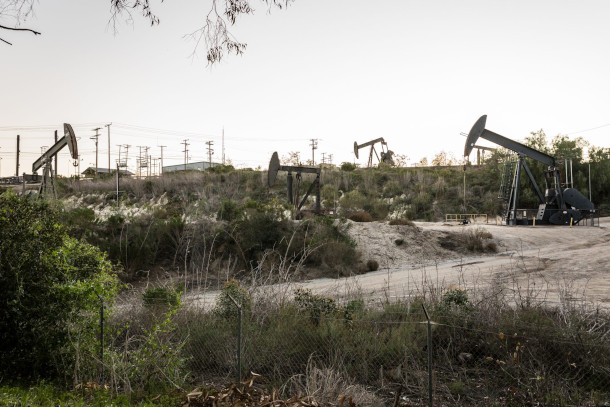
Oil wells in Los Angeles, California (Photo: Tamara Leigh Photography for the Goldman Environmental Prize)
DOERING: Back in the 1890s, prospectors struck “black gold” in the small city of Los Angeles, California. Just 50,000 people lived there at the time, and with little in the way of laws, drilling rigs quickly popped up across the city. 130 years later, LA is home to nearly 4 million people and more than 5,000 oil and gas wells, 700 of which are still active. Most of those active wells are sited in minority communities like University Park, where Nalleli Cobo grew up within 30 feet of a well owned by AllenCo Energy. Like much of her community, Nalleli suffered from chronic headaches, nosebleeds, stomach pain, asthma, and at the age of 19, she was diagnosed with cancer. Following treatment, Nalleli is now cancer free, but unable to have children. Nalleli’s health struggles motivated her to fight AllenCo Energy and ultimately forced the company to close the site across the street from her house. And 24 AllenCo executives are facing criminal charges for health and safety violations. For her work, Nalleli was awarded the 2022 Goldman Environmental Prize. Nalleli Cobo shared her story with Living on Earth’s Paloma Beltran.
BELTRAN: What are some of the long term health implications that University Park residents who resided near the operation of the AllenCo oil well exhibited?
COBO: Asthma is a really common one. My mom developed asthma at the age of 40, which is really rare, and my grandma at the age of 70, which is even more rare. Cancer is unfortunately common as well. A lot of thyroid issues, reproductive issues, and issues with fertility.
BELTRAN: So, how were you able to connect the health problems that you were suffering from to the AllenCo oil well?
COBO: It was when Physicians for Social Responsibility Los Angeles sent a toxicologist to come speak to my community that we really were able to connect the dots that certain chemicals used during oil extraction, such as hydrogen sulfide or benzene, can cause XY and Z health symptoms.
BELTRAN: And you really spearheaded an activism campaign that united celebrities and politicians and pushed AllenCo to act and take care of the contamination that they had been producing. Could you tell me about that process? How did you start? And where is it right now?
COBO: So, I started my activism at the age of nine without even knowing it was considered activism; I was doing what I felt needed to be done to protect my family and my community. It was going door to door knocking after school or reading a paragraph over 10 times to learn what fracking was and how it was harmful not only to our health and our safety but to our planet. And it was sticking with that, it was learning to share my story and learning that storytelling is a compelling form of activism that nobody can really take away from you. Like, I don't know all the science behind this, I don't know all the legal terms, but I know my story. I know how my body has been affected, how my family has been affected, and that's what I'm here to share.
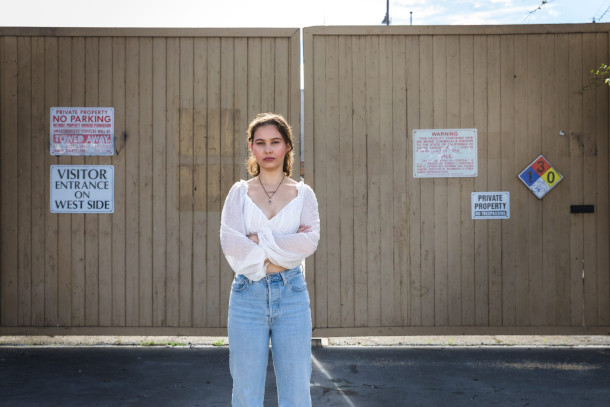
Nalleli Cobo stands in front of the closed AllenCo site (Photo: Tamara Leigh Photography for the Goldman Environmental Prize)
BELTRAN: You also co-founded the South Central Youth Leadership Coalition in 2015. And shortly after, the city of Los Angeles adopted new requirements for drilling applications. That's also a pretty big victory. Can you tell me more about that and the role that the South Central Leadership Coalition played?
COBO: Yeah, so SCYLC, the South Central Youth Leadership Coalition, along with Youth for Environmental Justice, we sued the city of Los Angeles for environmental racism and violation of CEQA, which is the California Environmental Quality Act, and we won. So now when expanding or applying to open wells, there is a new application itself and a memorandum.
BELTRAN: Can you tell me a little bit more about environmental racism across the United States?
COBO: Environmental racism is if someone wants to open an oil well, and they were looking to drill in the city of Wilmington, prior to our SCYLC and Youth for Environmental Justice lawsuit, they would approve them without basically even reading them, just green stamps, green stamps. And if I were then trying to open a well in predominantly a white community, for example, Culver City or Beverly Hills, then I would be told to make sure I only operate during the hours of nine to five when people typically aren't home. I would have to make sure that there are silent drills, I would have to make sure that special filters are put up, I would have to ensure that the outside is beautified with mosaics and tiles and flowers, and I could only use five oil wells. In my community, AllenCo had 21 oil wells and they would produce an average of 80 barrels of crude oil a day. That's environmental racism. It's seeing our community as less than. It's seeing our zip code, our socio-economic status, or ethnicity as deeming us as less valuable. And that's not true, nor is it right.
BELTRAN: Frontline communities across California and frankly across the United States have been historically left out of decision making processes, especially when it comes to decisions that involve exposure to toxic chemicals and health. How has your activism empowered you as a young Latina in a movement that's been mostly dominated by white voices?
COBO: I grew up extremely shy. I would not even leave my mom's side at a family party. And it was really my activism and my public speaking that told me it's okay to have your own voice, it's okay to have different thoughts than other people, it's okay to be the first to do something. And it doesn't matter that I don't know all the science, I don't know all the technical terms, I'm still learning, I'm human. I'm a 21 year old girl who's just in college trying to figure out her life like anybody else, but I'm also fighting for my community. And that's something my mom has always told me is the most important thing. And it was so important that us youth did that. It was us demanding a livable future. It was us saying we don't know all the science, we're not lawyers, we're not professionals, we're teenagers. But we're teenagers whose bodies have been on the front lines. We're teenagers who deserve to breathe clean air, we're teenagers who will go down with a fight. And we're powerful, we're not voiceless, and we're here to fight. And it was us claiming back our community in a way, because these oil industries will do studies to see what communities are more vulnerable. What communities know less about their rights or are more likely to keep their head down. And they chose the wrong community.
BELTRAN: How has your Latino background and your journey as an activist shaped your definition of community?
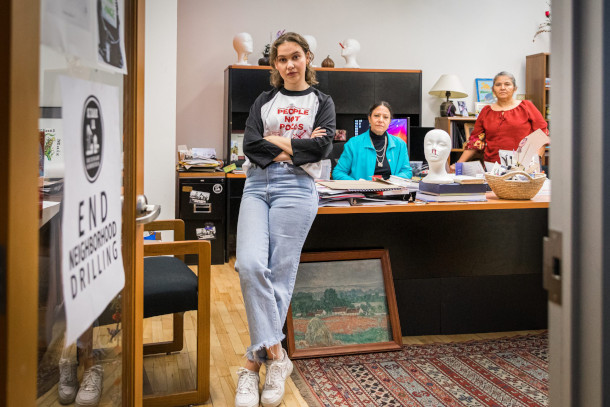
Nalleli Cobo and allies (Photo: Tamara Leigh Photography for the Goldman Environmental Prize)
COBO: I'm a very proud daughter of two immigrants. My mom immigrated here from Mexico, my father from Colombia. I'm also a proud product of a single mother. My community is the most beautiful community you can imagine. It's made up of the most hardworking people, people that work 14 to 16 hours a day to provide for their families. And we're still willing to go door to door knocking after that shift to educate other neighbors to protect their loved ones. Something that my mom has always said is that when she immigrated here, she never thought she'd have to fight an oil well to give us a better life. And I think that's the reality for most immigrants when they come here looking in search of a better life. They live next to refineries or factories or freeways. We don't realize how our bodies are being put on the front line in that aspect. And it was a no brainer to me that if sharing what has happened to me, what has happened to my body, can inspire others and create a change in my community, I could be the voice for my community. And that was always something I do with great honor.
BELTRAN: And it's thanks to you that you're not just breaking generational curses for your community, but for communities across the United States. So, in 2021, Governor Newsom proposed a statewide law to establish around a 3,200 foot buffer zone to separate homes, schools and hospitals from oil-gas wells. Can you walk us through what a safety buffer zone is and why this law would be so important for communities across California?
COBO: Yes, definitely. So when drilling for oil, there's many chemicals released into the air that are harmful to one's health. Scientists have shown that if you're within 2,500 feet away with an oil well, you're exposed to any of those toxic chemicals. California right now, the buffer zone is only 600 feet. And before we had no buffer zone. And it was up to us frontline community activists to say hey, we need to do something to protect our health and our safety and the environment. We should have something, I mean, AllenCo operates with nine surrounding schools in the area, and they share a wall with a high school for children with disabilities such as paraplegia. They share a wall with Mount St. Mary's College, and inside there is a daycare for newborns to two year olds. They live across the street from a senior living facility. These are the people that are breathing in those toxic chemicals. To these industries, we're just a speck, we're $1 or two. But we're humans. We're a 21 year old whose favorite color is pink and loves Justin Bieber. We are a 15 year old girl who wants to go to Harvard and study law. We are an 89 year old woman who immigrated here from Colombia with seven kids on her back. We are people with stories. And it's time that we stop choosing profit over people.
BELTRAN: And thanks to that, thanks to all of your work and bravery, AllenCo announced that it was suspending operations in that well that's 30 feet away from your home. And you mentioned that after you were notified that AllenCo was suspending operations of that well, you opened your window to smell the first breath of fresh air in years. Can you please tell me, what was that feeling like?
COBO: Yeah, I remember that day vividly. We were having dinner as a family, my sister was getting married the next day, so it was a big group of us, we were having caldo de papa. And all of a sudden my mom gets a phone call from work, and we're like, "Okay, it's late, like it must be something important." She steps away, but she starts crying. And we're like, "Tell us!" And then she hung up the phone and she was like "AllenCo is closing." And we just started screaming and jumping and we were like, "Oh my gosh, it's happening." And I just ran to the window and opened it, like something so simple, something that nobody thinks about doing in their own home, but something that we weren't able to do to protect our own health for years. So when we got to do that, even if it was for 30 seconds because it was late at night and it was really cold, it was really special for me to be able to do that.
DOERING: That’s Nalleli Cobo, recipient of the 2022 Goldman Environmental Prize for North America, speaking with Living on Earth’s Paloma Beltran. We reached out to AllenCo, but they declined to comment.
Related links:
- Learn more about Nalleli Cobo, 2022 Goldman Prize Winner for North America
- Nalleli Cobo’s Twitter
- Los Angeles Times | “State Serves a Warrant on AllenCo Oil Facility in South L.A.”
- The Guardian | “Los Angeles City Council Votes to Ban New Urban Oil And Gas Drilling In Historic Move"
[MUSIC: Ryosuke Kojima, “Flowing Rhyme” Single, GOON TRAX]
BASCOMB: Coming up – New research finds light pollution can make allergies worse.
That’s just ahead here on Living on Earth.
ANNOUNCER: Funding for Living on Earth comes from you, our listeners, and United Technologies, combining a passion for science with engineering to create solutions designed for sustainability in aerospace, building industries, and food refrigeration.
[CUTAWAY MUSIC: Ryosuke Kojima, “Flowing Rhyme” Single, GOON TRAX]
Beyond the Headlines
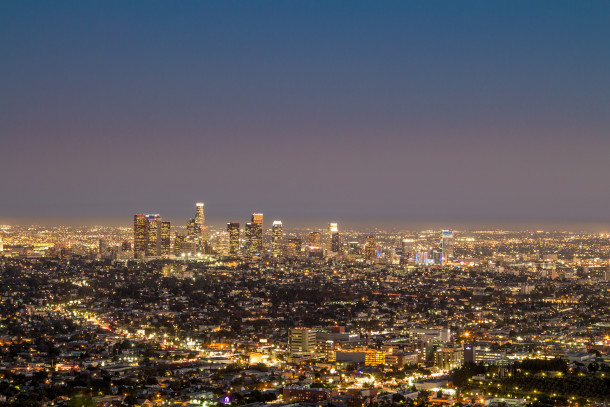
A new study from Iowa State University revealed that light pollution from urban areas can fool plants into having longer growing seasons, in turn lengthening allergy season. Light pollution can come from buildings, street lamps, parking lots, and other urban infrastructure. (Photo: Saad Chaudhry on Unsplash)
BASCOMB: It’s Living on Earth, I’m Bobby Bascomb.
DOERING: And I'm Jenni Doering.
And it's time this week for a look Beyond the Headlines with Peter Dykstra. Peter is an editor with Environmental Health News, that's ehn.org and dailyclimate.org, and he joins us, as always, from Atlanta, Georgia. Hey, Peter, how you doing this week?
DYKSTRA: I'm doing well, Jenni, and I want to talk a little bit about allergies. They've vexed me my whole life. But according to new research from Iowa State University, allergies could be lasting longer during the growing season because of light pollution.
DOERING: Really? How exactly is light pollution related to pollen and allergies, Peter?
DYKSTRA: The research showed that because of light pollution from streetlights, homes and businesses, parking lots, anything like that, in urban areas, when those lights burn into the night, it can fool some plants into having a longer growing season. That means a longer time with pollen in the air. And that in turn is a hazard for anyone who gets the sneezes and sniffles from allergy time.
DOERING: Well, this is really surprising, Peter, because I use lights to help my indoor plants grow, but that's a very special kind of light. And we're talking here about just your regular old street lamps.
DYKSTRA: Yeah, we're talking about light everywhere, at least in urban areas, and how they can be a hazard in ways we hadn't anticipated.
DOERING: Guess light pollution is nothing to sneeze at.
DYKSTRA: Nothing to sneeze at, there's a good one.
DOERING: Well, especially when you think about the impacts it has on species like bats and migrating birds.
DYKSTRA: And humans.
DOERING: That's right. Well, what else do you have for us this week?

A Congressional subcommittee has asked EPA to remove Seresto, a flea and tick collar (not pictured) associated with pet injuries and deaths, from the market for the second time. (Photo: Mitchell Orr on Unsplash)
DYKSTRA: There's a congressional panel that for the second time has asked the Environmental Protection Agency to take Seresto off the market. If you're a pet owner, you probably know what Seresto is. It is a high-selling pesticide-laden collar made for both dogs and cats to keep the fleas away.
DOERING: That's right, Peter. You know, LOE has been reporting on the illnesses and deaths that have been linked to this flea collar from Seresto. And I think even some data from the EPA itself has shown a link between those.
DYKSTRA: Right, studies from both the EPA and the Canadian government show fairly compelling evidence that Seresto can have a negative effect on some dogs, anything from skin irritation to death.
DOERING: Well, what does this mean now that the House Oversight Committee has told EPA: do something?
DYKSTRA: It didn't mean anything last time, but this time around the information that they have, they say is conclusive that there's a real problem.
DOERING: Well, for those of us who consider our pets part of our family, I hope that we can figure out and sort of prevent these things from happening. Well, Peter, what do you have for us this week from the history vaults?
DYKSTRA: On August 2, 1990, Iraq invaded Kuwait. The Iraqi leader Saddam Hussein said that Kuwait was historically a part of the Iraqi empire. It was widely presumed to be an oil war.
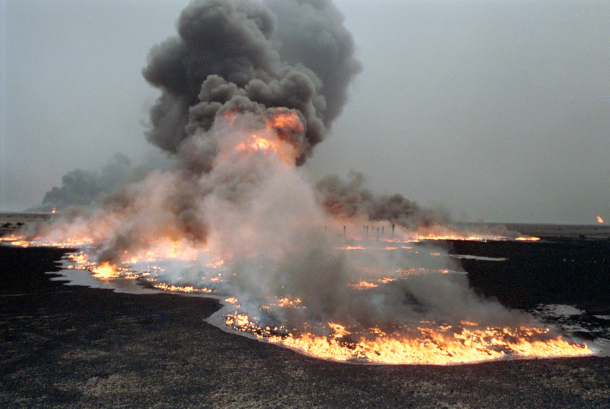
When Iraqi forces retreated from Kuwait in the spring of 1991, they left behind hundreds of burning oil wells, releasing 1.5 billion barrels of oil into the environment - the largest intentional oil spill in human history. (Photo: United Nations Photo, Flickr, CC BY-NC-ND 2.0)
DOERING: And that war over oil back in 1990 and 91 was actually the subject of the very first Living on Earth broadcast. The show covered those burning oil wells that the Iraqi forces set on fire as they retreated.
DYKSTRA: That's right, hundreds of wells on land and in the Persian Gulf in the largest intentional oil spill ever.
DOERING: Wow. It's an ugly link between fossil fuels and war. And I guess we haven't gotten over it yet, Peter.
DYKSTRA: We vowed to get over it back in 1990 and 91. It's clear that we didn't. And how much longer before we move to a clean energy economy that gets us out of the cycle of addiction to fossil fuels?
DOERING: Indeed. Well, thank you so much, Peter, as always. Peter Dykstra is an editor with Environmental Health News, that's ehn.org and dailyclimate.org. And we'll talk to you next time.
DYKSTRA: Okay, Jenni, thanks a lot, and we'll talk to you next time.
DOERING: And there's more on these stories at the Living on Earth website. That's loe.org.
Related links:
- Fast Company | “Allergies Lasting Longer? Blame Light Pollution”
- Investigate Midwest | “Chair of Congressional Subcommittee Investigating Seresto Collars Asks EPA To Take Product Off Market - Again”
- NASA | “Landsat Top Ten - Kuwait Oil Fires”
[MUSIC: Klawo, “The Müllers” on Klawo, Coastline Northern Cuts]
DOERING: To get the stories behind the stories on Living on Earth, as well as special updates, please sign up for the Living on Earth newsletter. Every week, you’ll find out about upcoming events and get a look at show highlights and exclusive content. Just navigate to the Living on Earth website, loe.org, and click on the newsletter link at the top of the page. That’s loe.org.
[MUSIC: Klawo, “The Müllers” on Klawo, Coastline Northern Cuts]
A Leg Up for a Baby Giraffe
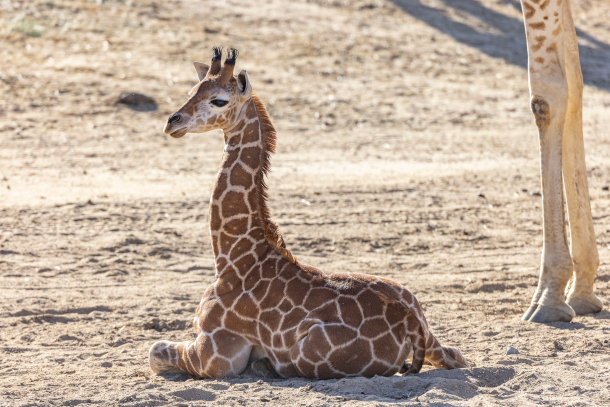
Msituni the giraffe was born in February of 2022. (Photo: Ken Bohn, courtesy of San Diego Zoo Safari Park)
DOERING: The tallest animals on Earth today are, of course, giraffes, which can grow up to 20 feet tall. Their six-foot legs need to be strong and sturdy to carry around a couple thousand pounds or more in body weight. So when one newborn giraffe at the San Diego Zoo Safari Park was having trouble walking, her caretakers knew they had to help. They fitted little Msituni, whose name means “in the forest” in Swahili, with special leg braces made just for her. Matt Kinney is senior veterinarian at the San Diego Zoo Safari Park, and he led the team that cared for baby Msituni. He joins me now from San Diego – Matt, welcome to Living on Earth!
KINNEY: Thanks, Jenni, how you doing?
DOERING: Good, thank you. So could you tell us a little bit about Msituni, please, this giraffe that was born just this year?
KINNEY: Yeah. Msituni was born February 1 of 2022. And she was born in one of our large field habitats to a first-time mother. And essentially, within hours of her birth, we recognized that there were some concerns with her forelimbs that required some veterinary intervention. We have a very talented group of wildlife care specialists that keep close eyes on the animals at all times. And they were able to very quickly detect that Msituni was unable to ambulate normally. It is her wrist joint, that's concerning her. But what's a little bit curious about that is it looks like a human knee joint, both in size and the way that it flexes and extends, and it actually goes in the same direction as a human knee joint, in that you can flex your knee almost all the way to your upper leg, but then when you go to extend it, it stops when it's essentially straight. So you can't go any further, if you were able to go any further, it would be hyperextending. And that's what we're seeing with Msituni, we were seeing that the joint was extending in a direction that is completely abnormal, even for neonate animals.
DOERING: Yeah, so what were the potential dangers that Msituni would face if she hadn't gotten leg braces?
KINNEY: Yeah, that's a great question. The biggest concerns that we had in the field was her need to be up and moving with the rest of the herd and with her mom, so she could get underneath her to nurse. Our other big concern with her was any kind of discomfort that she might be experiencing. So there's certainly a number of differential diagnoses or different causes for hyperextension of that joint. And some of them can be extremely painful, such as a fractured limb, or luxation, or an avulsion of a tendon. So that's something that we had to make certain that we ruled out. We didn't want her to be in any discomfort while she was in the field. So the next course of action was that she come to the hospital. It was not a decision that we took lightly, because with that one decision, we would be determining that we were gonna be hand rearing her, bottle rearing her. Usually, once they're removed from their mother like that for a medical problem, it's extremely hard to integrate the calves back with the dams, at least to the point that they'll start nursing. A lot of times you can integrate them back from a social standpoint, but if we removed Msituni from her dam, it would be a significant challenge to try to get her back. So we knew that going into the decision and had a pretty in depth conversation on the pros and cons. But ultimately, we knew that Msituni needed some pretty serious intervention.
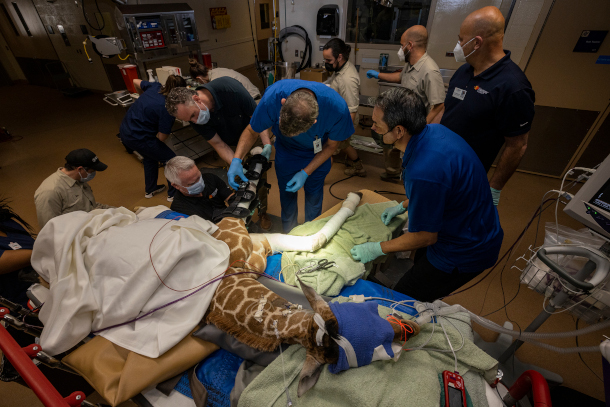
Msituni’s care team fit her for a leg brace. (Photo: Ken Bohn, courtesy of San Diego Zoo Safari Park)
DOERING: So, I got to know, how exactly do you make a leg brace for a giraffe? How did you go about this?
KINNEY: Yeah, that was a pretty long and complicated process for us. You know, we're pretty used to putting braces on animals. It's something that we do occasionally at the Safari Park. But the challenge with Msituni was her size, the joint that was involved, and then the degree of abnormalities that we were able to document. So our first attempt to stabilize that joint was pretty simple. And that was just placing a cast on the joint. So making sure that that joint was immobilized, so she couldn't cause any further damage to it. And that's an immediate fix that we're able to place in the hospital. The next step that we had to consider was how can we secure some kind of brace to that limb while allowing flexion and extension but preventing over, or hyperextension. That was just by going to a local pharmacy to buy an off-the-shelf ACL brace or human knee brace. And I had to do a little bit of sewing because the human knee is a little bit larger than her wrist joint at that time in her life.
DOERING: Oh, wow.
KINNEY: So yeah, we had to modify that quite a bit. And we quickly realized that that was not gonna be strong enough and we needed to come up with something that was more permanent. And at this point, we also recognized that her other forelimb was starting to hyperextend, too. So it wasn't just a problem with her right forelimb, but now had become a problem of her left forelimb, too. So we had another challenge on our hands. And that's when we got the Hanger Group that specializes in prosthetics and orthotics for humans to come in and help us with a medical grade, much more reinforced knee brace that is used in humans. And we made significant modifications to some of the bracing material and some of the straps to make sure that it would adhere closely to Msituni. And at that time, we put the brace on both forelimbs. And we did that while she was under anesthesia just for safety of both her and the people that are working on her. And it was pretty remarkable, when she recovered, she was able to stand right away, and was able to still move her joints in the normal direction. So she was able to flex her joints such that she could lay down on her own. It wasn't like a normal giraffe, it wasn't quite as eloquent as they're able to do it out in the field habitat. But she was able to navigate that pretty well. And it was really encouraging to see her lay down and get some rest at night, and be able to relax a little bit with that new brace. We knew that it wasn't going to be a long term fix, though, with a medical grade brace. And at that time, we were already working behind the scenes to develop a specialized brace that is custom-made just for Msituni. And that was that was a really neat experience too, with the Hanger Group.
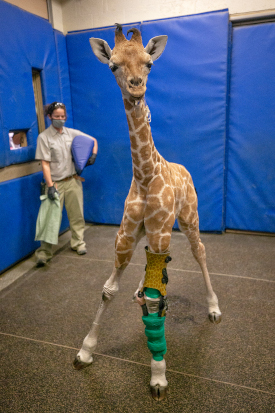
Msituni shows off her final custom leg brace, complete with giraffe print, from the Hanger Group. (Photo: Tammy Spratt, courtesy of San Diego Zoo Safari Park)
DOERING: How did they actually make that? Was it, like, 3D printed? Or, how did it work?
KINNEY: Yeah, it was pretty neat. They first casted Msituni. So, when she was under anesthesia, we were able to then do a negative mold. So we were able to get essentially a 3D, real life, accurate sized 3D model of what her forelimbs look like. And they're able to use that to help design the brace. The other thing that they used pretty significantly in the brace design and manufacturing was the computer tomography scan, that CT scan, we were able to provide them. So it provides an extremely detailed picture of what the forelimbs look like in a draft. And they were able to use that negative mold from the cast and the CT scan to be able to develop this custom brace. And the process for actually developing it was pretty remarkable, just given the timeline that they were able to get all the measurements, the molds, the CT scan, and then manufacture the brace. And in addition to just manufacturing something that from a mechanical standpoint would help her out, they also added a little artistic flair with some giraffe print on the outside.
DOERING: That's so neat that they were able to do that for her. How long did Msituni actually need these braces?
KINNEY: Yeah, all together, she had the braces on for about 40 days. And that's a combination of the initial cast that we had, that off-the-shelf ACL brace, the medical grade brace, and then the custom brace. She had the custom brace on for 10 days on her left forelimb. And we were actually able to take it off when she was awake, not under anesthesia, and it was a little bit of an anxious moment when we took it off just to see how she would start moving around. But she took those first couple steps, and we saw that that joint stayed in the right place that it should and everyone was really happy.
DOERING: So, how is Msituni doing now?
KINNEY: She's doing really well. The ultimate goal the whole time that she was here in hospital was to get her back out to the field habitat with the rest of the giraffe in our complex, multi-species habitats that would challenge her socially, physically, mentally. Well, essentially, our goal was to make sure that she was a thriving animal under our care. And pretty proud to say that with a lot of teamwork between the animal care staff, the hospital staff, and everyone else at the Safari Park, that she's thriving now out in the field habitat. So she's with the rest of the giraffe herd, and is integrated really well. She still is receiving bottles from the wildlife care specialists. And I'll actually feed her, I'll take a bottle out on the back of a pickup truck, one of the wildlife care specialist trucks, and she'll come over and take her bottle and once they leave, she knows that the feeding time's over, she'll go back to the herd and integrate back with them. So, it's been really neat to see. She's also helped us quite a bit with some of the other giraffe too, just her calm presence and her familiarity with some of the individuals that worked closely with her seems to have a little bit of a calming influence on other animals in the herd.
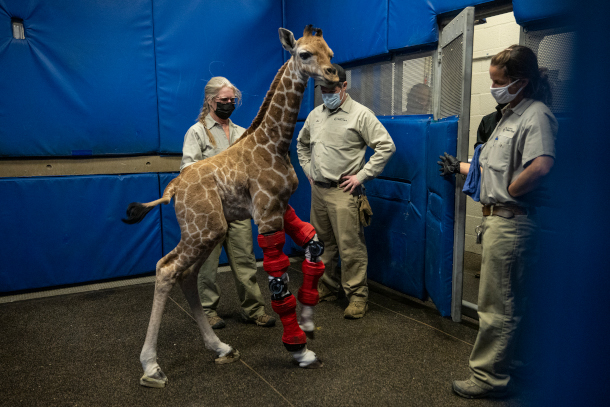
Msituni wearing two leg braces on her forelimbs (Photo: Ken Bohn, courtesy of San Diego Zoo Safari Park)
DOERING: Oh, wow. So, she's able to sort of help others out, too.
KINNEY: Yeah, I don't know if she knows it or not, but she's definitely paying it forward. You know, she's a really special animal and I think her calm demeanor really helped her with this case. I don't know if she realized that we were trying to help her at the time, but we certainly appreciated her as a patient.
DOERING: Matt Kinney is senior veterinarian at the San Diego Zoo Safari Park. Thank you so much, Matt.
KINNEY: Thank you, Jenni. It's been a pleasure.
Related link:
San Diego Zoo Wildlife Alliance | “Msituni the Giraffe Calf Is Up and Running”
[MUSIC: Wave Antonio Carlos Jobim - Wave 1967]
BASCOMB: Living on Earth is produced by the World Media Foundation. Our crew includes Naomi Arenberg, Paloma Beltran, Chloe Chen, Iris Chen, Josh Croom, Jenni Doering, Delaney Dryfoos, Mark Kausch, Mark Seth Lender, Don Lyman, Louis Mallison, Aynsley O’Neill, Sophia Pandelidis, Jake Rego, Hannah Richter, and Jolanda Omari.
DOERING: Tom Tiger engineered our show. Alison Lirish Dean composed our themes. You can hear us anytime at loe.org, Apple Podcasts, and Google Podcasts, and like us, please, on our Facebook page: Living on Earth. We tweet from @livingonearth. And find us on Instagram at livingonearthradio. Steve Curwood is our Executive Producer. I’m Jenni Doering.
BASCOMB: I’m Bobby Bascomb. Thanks for listening!
ANNOUNCER: Funding for Living on Earth comes from you, our listeners, and from the University of Massachusetts, Boston, in association with its School for the Environment, developing the next generation of environmental leaders. And from the Grantham Foundation for the protection of the environment, supporting strategic communications and collaboration in solving the world’s most pressing environmental problems.
ANNOUNCER 2: PRX.
Living on Earth wants to hear from you!
Living on Earth
62 Calef Highway, Suite 212
Lee, NH 03861
Telephone: 617-287-4121
E-mail: comments@loe.org
Newsletter [Click here]
Donate to Living on Earth!
Living on Earth is an independent media program and relies entirely on contributions from listeners and institutions supporting public service. Please donate now to preserve an independent environmental voice.
NewsletterLiving on Earth offers a weekly delivery of the show's rundown to your mailbox. Sign up for our newsletter today!
 Sailors For The Sea: Be the change you want to sea.
Sailors For The Sea: Be the change you want to sea.
 Creating positive outcomes for future generations.
Creating positive outcomes for future generations.
 Innovating to make the world a better, more sustainable place to live. Listen to the race to 9 billion
Innovating to make the world a better, more sustainable place to live. Listen to the race to 9 billion
 The Grantham Foundation for the Protection of the Environment: Committed to protecting and improving the health of the global environment.
The Grantham Foundation for the Protection of the Environment: Committed to protecting and improving the health of the global environment.
 Contribute to Living on Earth and receive, as our gift to you, an archival print of one of Mark Seth Lender's extraordinary wildlife photographs. Follow the link to see Mark's current collection of photographs.
Contribute to Living on Earth and receive, as our gift to you, an archival print of one of Mark Seth Lender's extraordinary wildlife photographs. Follow the link to see Mark's current collection of photographs.
 Buy a signed copy of Mark Seth Lender's book Smeagull the Seagull & support Living on Earth
Buy a signed copy of Mark Seth Lender's book Smeagull the Seagull & support Living on Earth

